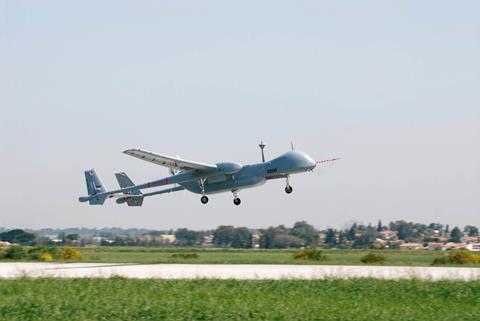As a family of unmanned Aircraft systems (UAS) the Heron brand comprises the Heron TP, Heron I, Heron MK II, and the new variant - T Heron (Tactical Heron) configured for maritime and land operations. The drone family shares ground segments, common systems, and mission payloads, enabling users to perform numerous missions, consolidate training, qualification, maintenance and logistics. IAI continue to evolve the Heron family, introducing new mission payloads and capabilities.

Long Runner - Remote Operations
Remote autonomous operation from forward locations is a unique new capability available with all Heron family members. This function enables operators to land a Heron at any airstrip within its range, without prior preparations or on-site instrumentation. Once landed the aircraft can be refueled, change payloads if necessary, and take off, all by remote control Using satellite communications (SATCOM). Furthermore, an aircraft based at such remote location can be launched on a mission without human support.
To autonomously land at a given location the Heron would survey the location, monitor the weather condition and wind direction, and autonomously plan its approach. It will transmit this plan to the operator for permission and once such permission is granted, will descend to the final approach. Once upon touchdown it slows, and taxi to the designated parking spot it allocated from the air. When full shutdown is necessary it is performed by the remote operator, who can also start-up the aircraft. Local support is necessary only in refueling.
Mission Operational and Intelligence Center (MOIC)
Long Runner functionality enables centralized management of multiple UAS missions from a single Mission Operation and Intelligence Center (MOIC). Instead of using separate ground control station for each platform, MOIC gathers numerous platforms, payloads and datalinks that utilizes a fleet of UAS in the most efficient and responsive way.

The center’s modular layout utilizes multiple mission operation cells supporting individual platforms, along with mission command, exploitation and C2 cells. The center shares mission trainers, SATCOM and support facilities and maintains a data storage center.
By centralizing and automating operations MOIC optimizes mission flow, from the planning and preparation phase, through mission command and control, to monitoring mission performance and data analysis of real-time and archived raw and processed information and debriefing.
By combining MOIC and Long Runner users can optimize UAS deployments, operating individual platforms from locations at or near their theatre of operation, thus dedicating most of the flight hours to useful operational missions, rather than transit in and out of the area of interest.
Innovative Unified Control
The latest workstation for Heron operators is the Innovative Unified Control Station (iUCS), an advanced multi-tasking system enabling operators to ‘fly the mission’, while the computer automatically ‘flies the platform’. iUCS conforms to NATO STANAG 4586 ED-2 and links to the specific platform through a Vehicle Specific Module (VSM) server. This way every ground station can seamlessly control all Heron family members.
This method simplifies operator training and qualification, as it allocates many tasks to series of computer enabled functions. This process improves mission reliability, by preventing common human errors and enables users to focus on the essential missions. Handling emergencies, loss contact or recovery are also activated with a click of a button. As a remotely piloted autonomous aircraft all the functions of the Heron are remotely controlled.
iUCS comprises a video wall and a touch screen tablet controller used for planning and interface with the system. Stick and hand grip are used for mission payload control.

With iUCS a drone operator can perform self-test, taxi and takeoff on a mission, all with a few clicks of a button. While airborne the operator can perform specific mission segments loaded to the system. iUCS fully supports the Heron’s wideband datalink and stores all sensors data for the entire flight, thus enabling situational analysis while the system continues to scan other targets with other sensors. iUCS automatically performs specific functions through the mission, such as change detection, revisit points of interest, or maintain a flight path through predefined corridors to obtain predefined overlap etc.
Ready for Emergency Response
While the Heron primary mission is military, these assets can rapidly be assigned to civilian roles, for example, responding to natural disasters or other emergencies. In such circumstances the Heron provides rapid situational assessment and real-time monitoring of the disaster area, delivering live video, motion detection and rapid assessment of the locations that need the most urgent assistance.
With large payload capacity and long endurance, the Heron can establish emergency communications services covering large areas, and link back to national, international and satellite networks. Furthermore, it can use cellular communications scanners to locate people trapped in collapsed buildings or isolated in flooded areas, by detecting their mobile phones. Maritime Herons are particularly useful in response to emergencies at sea, providing rapid situation assessment, constant monitoring of the affected area, or use multispectral imaging techniques to assess environmental damage, when tracing oil spills and pollutions.
To further support first responders the Heron can be equipped with direct messaging capability, enabling users to receive automatic alerts direct from the drone. Such alerts can include text, image or video.

























